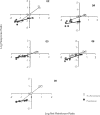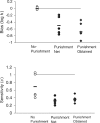Asymmetry of reinforcement and punishment in human choice
- PMID: 18422016
- PMCID: PMC2251321
- DOI: 10.1901/jeab.2008.89-157
Asymmetry of reinforcement and punishment in human choice
Abstract
The hypothesis that a penny lost is valued more highly than a penny earned was tested in human choice. Five participants clicked a computer mouse under concurrent variable-interval schedules of monetary reinforcement. In the no-punishment condition, the schedules arranged monetary gain. In the punishment conditions, a schedule of monetary loss was superimposed on one response alternative. Deviations from generalized matching using the free parameters c (sensitivity to reinforcement) and log k (bias) were compared in the no-punishment and punishment conditions. The no-punishment conditions yielded values of log k that approximated zero for all participants, indicating no bias. In the punishment condition, values of log k deviated substantially from zero, revealing a 3-fold bias toward the unpunished alternative. Moreover, the c parameters were substantially smaller in punished conditions. The values for bias and sensitivity under punishment did not change significantly when the measure of net reinforcers (gains minus losses) was applied to the analysis. These results mean that punishment reduced the sensitivity of behavior to reinforcement and biased performance toward the unpunished alternative. We concluded that a single punisher subtracted more value than a single reinforcer added, indicating an asymmetry in the law of effect.
Figures



Similar articles
-
Token reinforcement: a review and analysis.J Exp Anal Behav. 2009 Mar;91(2):257-86. doi: 10.1901/jeab.2009.91-257. J Exp Anal Behav. 2009. PMID: 19794838 Free PMC article. Review.
-
Quantification of ethanol's antipunishment effect in humans using the generalized matching equation.J Exp Anal Behav. 2009 Sep;92(2):161-80. doi: 10.1901/jeab.2009.92-161. J Exp Anal Behav. 2009. PMID: 20354597 Free PMC article.
-
Effects of point-loss punishers on human signal-detection performance.J Exp Anal Behav. 2009 Jul;92(1):17-39. doi: 10.1901/jeab.2009.92-17. J Exp Anal Behav. 2009. PMID: 20119520 Free PMC article.
-
An implementation of punishment in the evolutionary theory of behavior dynamics.J Exp Anal Behav. 2019 Sep;112(2):128-143. doi: 10.1002/jeab.543. Epub 2019 Aug 5. J Exp Anal Behav. 2019. PMID: 31385310
-
Punishment and dynamic choice: Assessment of the direct-suppression model.J Exp Anal Behav. 2025 Mar;123(2):158-175. doi: 10.1002/jeab.4237. Epub 2025 Jan 30. J Exp Anal Behav. 2025. PMID: 39887366
Cited by
-
Effects of repeated exposure to escalating versus constant punishment intensity on response allocation.J Exp Anal Behav. 2022 Jul;118(1):59-82. doi: 10.1002/jeab.766. Epub 2022 May 12. J Exp Anal Behav. 2022. PMID: 35553429 Free PMC article.
-
Human responding on random-interval schedules of response-cost punishment: the role of reduced reinforcement density.J Exp Anal Behav. 2010 Jan;93(1):5-26. doi: 10.1901/jeab.2010.93-5. J Exp Anal Behav. 2010. PMID: 20676265 Free PMC article.
-
Token reinforcement: a review and analysis.J Exp Anal Behav. 2009 Mar;91(2):257-86. doi: 10.1901/jeab.2009.91-257. J Exp Anal Behav. 2009. PMID: 19794838 Free PMC article. Review.
-
Rimonabant's reductive effects on high densities of food reinforcement, but not palatability, in lean and obese Zucker rats.Psychopharmacology (Berl). 2014 May;231(10):2159-70. doi: 10.1007/s00213-013-3366-4. Epub 2014 Jan 8. Psychopharmacology (Berl). 2014. PMID: 24398820 Free PMC article.
-
Effects of and preference for conditions of token earn versus token loss.J Appl Behav Anal. 2014 Fall;47(3):537-48. doi: 10.1002/jaba.135. Epub 2014 May 21. J Appl Behav Anal. 2014. PMID: 24844817 Free PMC article.
References
Publication types
MeSH terms
LinkOut - more resources
Full Text Sources

